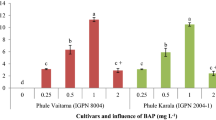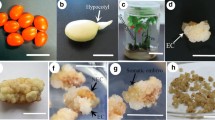Abstract
The present investigation was carried out to establish a simple and efficient in vitro method for rapid propagation of Daucus carota L for different applications. Root, stem, leaf and seed explants were tested to induce callus on Gamborg medium supplemented with 2,4-Dichlorophenoxyacetic acid (2,4-D) for cell suspension culture establishment. The leaf, stem, seed explants induced calluses were more embryogenic and viable when compared to callus derived from tap root explants. Plant regeneration potential of embryogenic callus from tap root showed very slow response producing only fewer shoots, whereas the response of other explants derived calluses like stem, leaves and seeds exhibited rapid multiple shoot formation within three weeks’ time. Tap root derived suspension culture showed more clumps with less viable embryogenic cells, in contrast to the stem and seed derived suspension cultures, where cells were more embryogenic and proliferative. Explant, concentration of carbohydrates, 2,4-D and amino acids were tested for embryo induction response and it was found that 3% sucrose, 1.0 mg/L 2,4-D and amino acid alanine had great influence on embryo induction. The somatic embryos were subjected to desiccation prior to plating on the regeneration medium. It was found that 1 h desiccation increased the regeneration percentage of the embryos and the conversion frequency of embryos to plants decreased on increased desiccation time. These optimized conditions will be very useful for studies involving genetic transformation, cell cycle, cell proliferation, synthetic seed production and other physiological studies of D. carota species.







Similar content being viewed by others
References
Ammirato PV (1986) Carrot. In: Evans DA, Sharp WR, Ammirato PV (eds) Handbook of plant cell culture: techniques and application, vol 4. Macmillan, New York, pp 457–499
Brown DC, Finstad KI, Watson EM (1995) Somatic embryogenesis in herbaceous dicots. In: In vitro embryogenesis in plants. Springer, Dordrecht, pp 345–415
Ceasar SA, Ignacimuthu S (2010) Effects of cytokinins, carbohydrates and amino acids on induction and maturation of somatic embryos in kodo millet (Paspalum scorbiculatum Linn.). Plant Cell Tissue Organ Cult 102:153–162. https://doi.org/10.1007/s11240-010-9716-6
Chand S, Sahrawat AK (2001) Stimulatory effect of partial desiccation on plant regeneration in indica rice (Oryza sativa L.). J Plant Biochem Biotechnol 10:43–47. https://doi.org/10.1007/BF03263105
Corredoira E, Valladares S, Vieitez AM, Ballester A (2008) Improved germination of somatic embryos and plant recovery of European chestnut. In Vitro Cell Dev Biol- Plant 44:307–315. https://doi.org/10.1007/s11627-008-9105-6
De Gloria FJM, Filho FDAM, Mende BMJ (2000) Plant regeneration from protoplast of Brazilian citrus cultivars. Pesqui Agropecu Bras 35:727–732. https://doi.org/10.1590/S0100-204X2000000400008
Dunstan DI, Tautoris TE, Thorpe TA (1995) Somatic embryogenesis in woody plants. Zn. In: Thorpe TA (ed) In vitro embryogenesis in plants. Kluwer Academic Publishers, Boston, pp 471–540. https://doi.org/10.1104/pp.112.2.549
Elhag HM, Whipkey A, Janick J (1987) Induction of somatic embryogenesis from callus in Theobroma cacao in response to carbon source and concentration. Rev Theobroma 17:153–162
Feher A, Pasternak TP, Dudits D (2003) Transition of somatic plant cells to an embryogenic state. Plant Cell Tissue Organ Cult 74:201–228. https://doi.org/10.1023/A:1024033216561
Gaj MD (2004) Factors influencing somatic embryogenesis induction and plant regeneration with particular reference to Arabidopsis thaliana (L.) Heynh. Plant Growth Regul 43:27–47. https://doi.org/10.1023/B:GROW.0000038275.29262.fb
Gamborg OL, Miller RA, Ojima K (1968) Nutrient requirements of suspension cultures of soybean root cells. Exp Cell Res 50:151–158. https://doi.org/10.1016/0014-4827(68)90403-5
Guy CL (1990) Cold acclimation and freezing stress tolerance: role of protein metabolism. Annu Rev Plant Physiol Plant Mol Biol 41:187–223. https://doi.org/10.1146/annurev.pp41.060190.001155
Halperin W, Jensen WA (1967) Ultrastructural changes during growth and embryogenesis in carrot cell cultures. J Ultrastruct Res 18:428–443. https://doi.org/10.1016/S0022-5320(67)80128-X
Horvitz MA, Simon PW, Tanumihardjo SA (2004) Lycopene and β-carotene are bioavailable from lycopene ‘red’ carrots in humans. Eur J Clin Nutr 58:803–811. https://doi.org/10.1038/sj.ejcn.1601880
Kadota M, Imizu K, Hirano T (2001) Double-phase in vitro culture using sorbitol increases shoot proliferation and reduces hyperhydricity in Japanese pear. Sci Hortic 89:207–215. https://doi.org/10.1016/S0304-4238(00)00234-X
Kamada H, Harada H (1979) Studies on the organogenesis in carrot tissue cultures II. Effects of amino acids and inorganic nitrogenous compounds on somatic embryogenesis. Z Pflanzenphysiol 91:453–463. https://doi.org/10.1016/S0044-328X(79)80259-7
Kamada HK, Kobayashi T, Kiyosue, Harada H (1989) Stress induced somatic embryogenesis in carrot and its application to synthetic seed production. In Vitro Cell Dev Biol-Plant 25:1163–1166. https://doi.org/10.1007/BF02621268
Kochhar S L (Ed.) (1998) Economic botany in the tropics. Macmillan India Ltd, Delhi, p 608
Komamine A, Kawahara R, Matsumoto M, Sunabori S, Toya T, Fujiwara A, Tsukuhara M, Smith J, Ito M, Fukuda H, Nomura K, Fujimura T (1992) Mechanisms of somatic embryogenesis in cell cultures: physiology, biochemistry, and molecular biology. In Vitro Cell Dev Biol-Plant 28:11–14. https://doi.org/10.1007/BF02632185
Liu L, Earl GM, Eve SW (1994) Accumulation of petroselinic acid in developing somatic carrot embryos. Phytochem 37:749–753. https://doi.org/10.1016/S0031-9422(00)90351-0
Loiseau J, Marche C, Le Deunff Y (1995) Effects of auxins, cytokinins, carbohydrates and amino acids on somatic embryogenesis induction from shoot apices of pea. Plant Cell Tissue Organ Cult 41:267–275. https://doi.org/10.1007/BF00045091
Mendoza MG, Kaeppler HF (2002) Auxin and sugar effects on callus induction and plant regeneration frequencies from mature embryos of wheat (Triticum aestivum L.). In Vitro Cell Dev Biol-Plant 38:39–45. https://doi.org/10.1079/IVP2001250
Mingozzi M, Montello P, Merkle S (2009) Adventitious shoot regeneration from leaf explants of eastern cottonwood (Populus deltoides) cultured under photoautotrophic conditions. Tree Physiol 29:333–343. https://doi.org/10.1093/treephys/tpn029
Murashige T, Skoog F (1962) A revised medium for rapid growth and bioassays with tobacco tissue cultures. Physol Plant 15:473–497. https://doi.org/10.1111/j.1399-3054.1962.tb08052.x
Nomura K, Komamine A (1985) Identification and isolation of single cells that produce somatic embryos at a high frequency in a carrot suspension culture. Plant Physiol 79:988–991. https://doi.org/10.1104/pp.79.4.988
Nomura K, Komamine A (1986) Molecular mechanisms of somatic embryogenesis. Oxford Surveys Plant Mol Cell Biol 3:456–466
Ozawa K, Komamine A (1989) Establishment of a system of high-frequency embryogenesis from long-term cell suspension cultures of rice (Oryza sativa L.). Theor Appl Genet 77:205–211. https://doi.org/10.1007/BF00266188
Pant B, Manandhar S (2007) In vitro propagation of carrot (Daucus Carota.L). Sci World 5:51–53. https://doi.org/10.3126/sw.v5i5.2656
Pawlicki N, Sangwan R, Sangwan Norreel B (1992) Factors influencing the Agrobacterium tumefaciens mediated transformation of carrot (Daucus carota L.). Plant Cell Tissue Organ Cult 31:129–139. https://doi.org/10.1007/BF00037697
Pescador R, Kerbauy GB, De Melo Ferreira W, Purgatto E, Suzuki RM, Guerra MP (2012) A hormonal misunderstanding in Acca sellowiana embryogenesis: levels of zygotic embryogenesis do not match those of somatic embryogenesis. Plant Growth Regul 68:67–76. https://doi.org/10.1007/s10725-012-9694-2
Rabiei K, Polyakov A, Khodambashi M, Sharafova O, Kalashnikova E, Hooshmand S, Omidi M (2010) Carrot (Daucus carota L.) in vitro regeneration. Vegetable Crop Res Bul 73:13–22. https://doi.org/10.2478/v10032-010-0014-y
Raghavan V (2006) Can carrot and Arabidopsis serve as model systems to study the molecular biology of somatic embryogenesis? Curr Sci 90:1336–1343
Ribnicky DM, Ilic N, Cohen JD, Cooke TJ (1996) The effects of exogenous auxins on endogenous indole-3-acetic acid metabolism (the implications for carrot somatic embryogenesis). Plant Physiol 112:549–558. https://doi.org/10.1104/pp.112.2.549
Ruduś I, Kępczyńska E, Kępczyński J (2006) Comparative efficacy of abscisic acid and methyl jasmonate for indirect somatic embryogenesis in Medicago sativa L. Plant Growth Regul 48:1. https://doi.org/10.1007/s10725-005-5136-8
Shiota H, Tachibana K, Watabe K, Kamada H (1999) Successful long-term preservation of abscisic acid-treated and desiccated carrot somatic embryos. Plant Cell Rep 18:749–753. https://doi.org/10.1007/s002990050654
Sotiropoulos TE, Molassiotis AN, Mouhtaridou GI, Papadakis I, Dimassi KN, Therios IN, Diamantidis G (2006) Sucrose and sorbitol effects on shoot growth and proliferation in vitro, nutritional status and peroxidase and catalase isoenzymes of M 9 and MM 106 apple (Malus domestica Borkh.) rootstocks. Eur J Hortic Sci 71:114–119
Steward FC, Mapes MO, Mears K (1958) Growth and organized development of cultured cells. II. Organization in cultures grown from freely suspended cells. Am J Bot 45:705–708. https://doi.org/10.1002/j.1537-2197.1958.tb10599.x
Tsukahara M, Hirosawa T (1992) Simple dehydration treatment promotes plantlets regeneration of rice (Oryza sativa L.) callus. Plant Cell Rep 13:647–665. https://doi.org/10.1007/BF00233090
Tyagi RK, Agrawal MC, Hussain Z, Tyagi H (2007) Low-cost media for in vitro conservation of turmeric (Curcuma longa L.) and genetic stability assessment using RAPD markers. In Vitro Cell Dev Biol-Plant 43:51–58. https://doi.org/10.1007/s11627-006-9000-y
Yang YS, Zheng YD, Chen YL (1999) Improvement of plant regeneration from long-term cultured calluses of Taipei 309, a model rice variety in in vitro studies. Plant Cell Tissue Organ Cult 57:199–206. https://doi.org/10.1023/A:1006329323694
Yildiz M, Onde S, Ozgen M (2007) Sucrose effects on phenolic concentration and plant regeneration from sugarbeet leaf and petiole explants. J Sugar Beet Res 44:1
Acknowledgments
Author Sathish. S acknowledges Indian Council for Medical Research, New Delhi, India (No.3/1/2/102/2018-Nut.) for fellowship support. Safia N thanks University Grants Commission- Basic Science Research, New Delhi for fellowship support (UGC BSR No. F.25.1/2014-15). Dr. Sivakumar. S thanks National Post-Doctoral Fellowship (Sanction Order No: PDF/2016/002258), Science and Engineering Research Board, Department of Science and Technology, Government of India. We would also like to thank, University Grants Commission-Special Assistance Programme and Department of Science & Technology-Fund for Improvement of S&T Infrastructure for the financial support to carry out this research.
Author information
Authors and Affiliations
Corresponding author
Ethics declarations
Conflict of interest
The authors declare that there is no conflict of interest.
Additional information
Publisher’s note
Springer Nature remains neutral with regard to jurisdictional claims in published maps and institutional affiliations.
Electronic supplementary material
Figure. S1
In vitro grown carrot plants used for explant preparation a b seedling grown in MS medium at 4 and 6 weeks c d individual plantlets used for steam and leaf explant preparation e lateral and tap root explants after excision Scale bar = 5 cm;d = 3cm (PDF 11662 kb)
Rights and permissions
About this article
Cite this article
Sundararajan, S., Nayeem, S., Subiramani, S. et al. Optimizing culture conditions for high frequency somatic embryogenesis and plantlet conversion in Daucus carota L. Biologia 74, 695–707 (2019). https://doi.org/10.2478/s11756-019-00223-0
Received:
Accepted:
Published:
Issue Date:
DOI: https://doi.org/10.2478/s11756-019-00223-0




